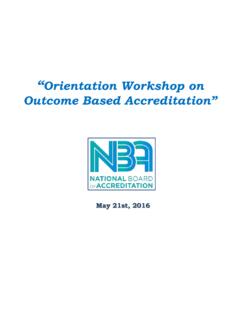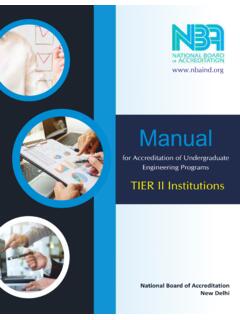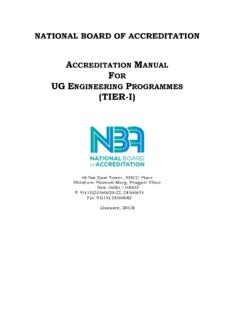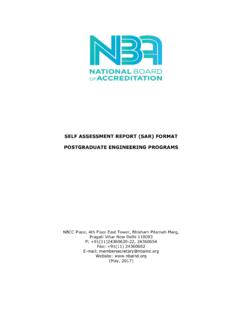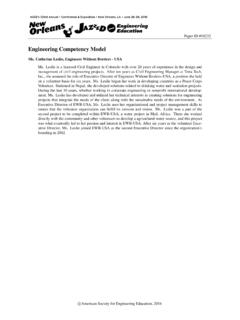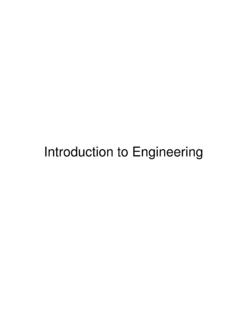Transcription of Accreditation- Evaluator’s View - National Board of ...
1 Accreditation- Evaluator s View Why accreditation and What is it? What do we evaluate? Against what criteria? Why & What of OBE? Evidence and its role. Evaluators Plays a Key -AccreditationBasic IssuesQu. What is accreditation ?And, What does it do?It Provides Assurance about Program Quality*Qu. Who are these Stakeholders? Students and their Parents Institutions Industry Faculty What accreditation is NOT? a ranking procedure (Gold, Silver, 1,2,3,..) an Investigation (There has been no complaint)3.(Should not be), A Regulatory Even an AuditAccreditation is not a ranking does not rank programs in any way. What is it then? It is a Process by Institution being looked at is given a SEAL of approval by stakeholders in its activity -as meeting their expectations.(Stakeholders: Students, Govt., Industry, Faculty,..)Truly, the Processes discussed in this presentation are of use to the Institution- accreditation or OtherwiseKey Terms Program Educational Objectives, PEO Graduate Profile, & Program Outcomes, PO accreditation Criteria Course Outcomes, CO Assessment Evaluation We will define and discuss all theseProgram Educational Objective-PEOP rogram Educational Objectives Essentially Answer the Question: Why does the Program exist in the first place?
2 It has to be answered by the management in Consultation with all the Stakeholders!Qu. Employment Scenario?Shadow of the IT!STARTING POINTNBA s accreditation ProcessAccreditation Model .. Modern Trend: Objectives / Outcomes* Outcomes are Measurables Detailed Evaluation Guidelines Allows the Institution to Assess itself (and Change) Assesses in a two tier system. One more suitable for the autonomous, other for the affiliated {Your role and tasks change depending on the tier} Infrastructure part plays a much smaller roleSAR Structure Institutional: Infrastructure, Finance, Admissions, Governance, Faculty, etc Department/ProgramRelated Academics: Curriculum,Objectives / Outcomes* accreditation Process Flow Institution-Complete the SAR Institution-Evaluate yourself and Bridge Gaps that you find (Leads to Improvements in the Institution s Functioning ) Pre-qualifiers Go No Go Evaluators-Initial Assessment based on SAR and Observations thereon Visit Judgments Based on EvidenceAccreditation Criteria-On Which, to make the JudgmentAccreditation Criteria-NBAC rirterion1: Vision, Mission and Program Educational ObjectivesCriterion2: Program OutcomesCriterion3: Program CurriculumCriterion4: Student PerformanceCriterion5: Faculty ContributionsCriterion6: Facilities and Technical SupportCriterion7.
3 Academic Support and Teaching and Learning processCriterion8: Governance, Institutional Support and Financial ResourcesCriterion9: Continuous ImprovementHow to make the judgment?As dictated by the accreditation Criteria-Slide18 SAR-Evaluations Vision and Mission Program Outcomes (PO) Course Outcomes (CO) Consistency and Interactions Amongst These-MatricesProcess Structure (Skeletal)Program Outcomes/Graduate Profile(To be achieved)Teaching/Learning: Curriculum, Faculty, Assessment & Evaluation(Design and implementation component)Assessment and Evaluation Attainment of Graduate ProfileAccredit?Revise?Graduate Profile&Washington AccordGraduate Profile Profile of the Graduates-Target The Profile should (and does) meet requirements of all the Stakeholders. AND Is in line with the Profile as defined by the WA Defining this is the Starting PointWhy the NBA s POs are-What they are?Washington Accord Attributes NBA Program Outcomes.
4 Knowledge,Apply knowledge of mathematics, science, engineering fundamentals and an engineering specialization to the solution of complex engineering knowledge, Apply the knowledge of mathematics, science, engineering fundamentals, and engg. specialization to the solution of complex engineering problems2. Problem Analysis,Identify, formulate, research literature and analyze complex engineering problems reaching substantiated conclusions using first principles of mathematics, natural sciences and engineering sciences2. Problem Analysis, Identify, formulate, research literature, and analyze engineering problems to arrive at substantiated conclusions using first principles of mathematics, natural, and engineering Graduate Attributes and NBA-Program OutcomesCrux of the Matter Program OutcomesNBA-Program Outcomes1. Engineering Knowledge,2. Problem Analysis 3. Design/development of solutions,4. Conduct investigations of complexProblems, 5.
5 Modern tool usage,6. The engineer and society, 7. Environment and sustainability,8. Ethics,9. Individual and team work, 10. Communication, 11. Project management and finance, 12. Life-long learningPOs-Working and Validation of Course Outcomes and their mapping to Program Course Outcomes (COs) and Program Outcomes (POs) Assessment tools employed for evaluation of level of attainment for COs (and evidence for this) Attainment Levels for the processes {This and the next slide} {It should also be in the SAR}Evaluation of the attainment of the Programme of evaluation of each PO. (to be recorded)What are the levels of attainment? the results of evaluation were used for curricular improvements?(Continuous Improvement --Criterion-9){SAR Again!}We Examine only Two CriteriaCriterion2: Program OutcomesCriterion3: Program CurriculumRole of the two criteria Program Curriculum PO Program Outcomes Curriculum and the Teaching/ Learning processes are the basis on which the program is built Attainment of POs indicates that the job is well doneCurriculumCurriculumCurriculum, Assessment and Evaluation are the major tools by which Program Outcomes are attained.
6 We should look at all of these together. These need to be designed Contents of Basic Science, Humanities, and Program Specific Courses Core, Elective {Balanced?}2 Content Delivery3 Laboratory Work4 Project WorkStructure of a Typical Engineering CurriculumQu. Will We be able to Attain POsUnder the Curriculum?Participants in Curriculum Review/ Design More True for Tier-1, But .. Faculty {Team} Industry Academics from Peer Institutions {Very Desirable} Students and Alumni Academic BodiesHere the entire responsibility rests with the InstitutionsFrameworkPEOP rogram OutcomesCurriculum &Teaching, LearningCourse Outcomes123 Curriculum Design Flow Define PEOs Place Starting Design alongside NBA s Program Outcomes. Can you cover All POswithin the Credit Limit Requirements? If Yes, thenSequencing Requirements? Else, In a Few iterations a Solution should emergeFor Evaluators Records?Sample SyllabusCourse: Electrical Circuits and Network in either 2nd or 3rd semester to students of Electrical Sciences.
7 Credits: (Typical) 3-1-0. Course is Objective: To prepare a student to take courses normally offered in subsequent semesters, like: Electronic Circuits, Signals and Systems, Advanced Electronics, : The circuit concept as an approximation to a physical system {modeling, Application of laws of physics (PO 1)}.Kirchoff sLaws, voltage and current sources, Network equations, use of source transformations, Loop and Nodal analysis, Matrix representation of circuit equations and their solutions {Apply knowledge of mathematics (PO1)} response, solution of differential equations with constant coefficients, initial and final conditions, time constant, its physical significance, and use in solving engineering problems {PO 2 particularly, switching circuits}.Use of Laplace transform in circuit analysis {again PO 1}Two-port networks, two-port parameters {necessary for all the electronics systems that would follow}, sinusoidal steady state analysis and frequency responseUse of computers for solving large problems {PO 5}Text books: Valkenburg, Network Analysis, 3rd Edition, PHI.
8 {For an 8 credit advanced course}2. V Del Toro, Electrical Engineering Fundamentals, 2nd Edition {For a 6 credit standard course}Course Outcomes: PO 1, PO 2, PO 5 Reference: The Mathematics of Circuit Analysis, Guillemin, Oxford & IBHC urriculumCourse OutcomesProgram OutcomesIf True, DoneTeaching/Learning/Assessment/Evaluat ionsMathematics, Physics, Basic Engineering Sciences, Humanities, CommunicationCore (Compulsory) Electrical Engineering Courses{Electives}Type 1 Type 2 Type 3 Type 4 Broad OutlineProjects, Internships, Assignments, ..Typical CoreComposition for EE Mathematics 4/5 courses Physics 3/4 Courses Chemistry 1/2 Biology (?) 1 Humanities and Social Sciences 3/4 Maths: Calculus (1/2), Linear Algebra, Discrete Maths, Complex VariablesPhysics: General Physics, Electricity & Magnetism (Adv), Modern Physics, Coffee Break?NBA s Program OutcomesThey are interesting!
9 NBA-Program Outcomes1. Engineering Knowledge,2. Problem Analysis 3. Design/development of solutions,4. Conduct investigations of complex Problems, 5. Modern tool usage,6. The engineer and society, 7. Environment and sustainability,8. Ethics,9. Individual and team work, 10. Communication, 11. Project management and finance, 12. Life-long learningPROGRAM OUTCOMES PO Have to be understood Some Difficult to Attain Also, Difficult to Assess and Evaluate We examine all these aspects1. Engineering knowledge:Apply the knowledge of mathematics, science, engineering fundamentals, and engg. specialization to the solution of complex engineering Problem analysis:Identify, formulate, research literature, and analyze engineering problems to arrive at substantiated conclusions using first principles of mathematics, natural, and engineering Design/development of solutions:Design solutions for complex engineering problems and design system components, processes to meet the specifications with consideration for the public health and safety, and the cultural, societal, and environmental Conduct investigations of complex problems:Use research-based knowledge including design of experiments, analysis and interpretation of data, and synthesis of the information to provide valid Modern tool usage:Create, select, and apply appropriate techniques, resources, and modern engineering and IT tools including prediction and modeling to complex engineering activities with an understanding of the The engineer and society.
10 Apply reasoning informed by the contextual knowledge to assess societal, health, safety, legal, and cultural issues and the consequent responsibilities relevant to the professional engineering Environment and sustainability:Understand the impact of the professional engineering solutions in societal and environmental contexts, and demonstrate the knowledge of, and need for sustainable Ethics:Apply ethical principles and commit to professional ethics and responsibilities and norms of the engineering Individual and team work:Function effectively as an individual, and as a member or leader in teams, and in multidisciplinary Communication:Communicate effectively with the engineering community and with society at large. Be able to comprehend and write effective reports documentation. Make effective presentations, and give and receive clear Project management and finance:Demonstrate knowledge and understanding of engineering and management principles and apply these to one s own work, as a member and leader in a team.
